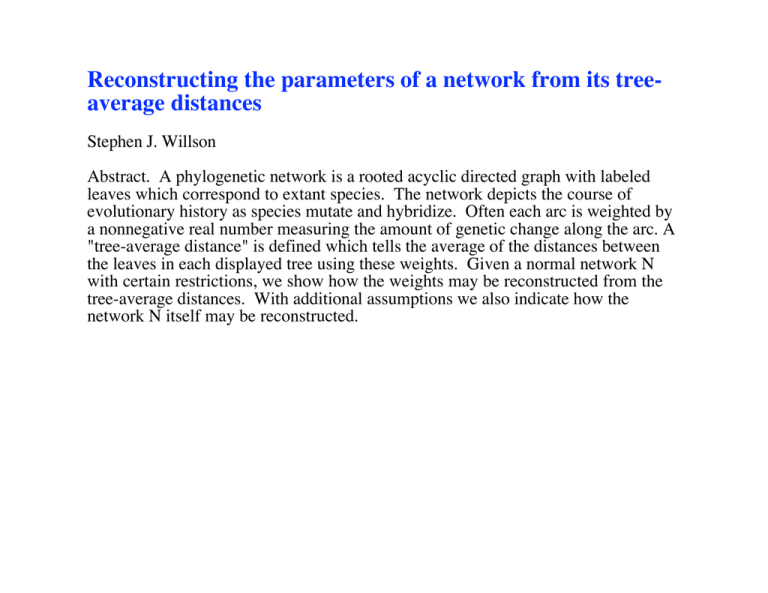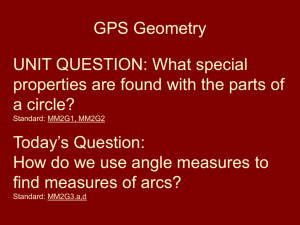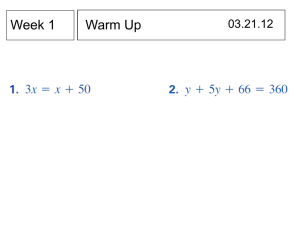Reconstructing the parameters of a network from its tree- average distances
advertisement

Reconstructing the parameters of a network from its treeaverage distances
Stephen J. Willson
Abstract. A phylogenetic network is a rooted acyclic directed graph with labeled
leaves which correspond to extant species. The network depicts the course of
evolutionary history as species mutate and hybridize. Often each arc is weighted by
a nonnegative real number measuring the amount of genetic change along the arc. A
"tree-average distance" is defined which tells the average of the distances between
the leaves in each displayed tree using these weights. Given a normal network N
with certain restrictions, we show how the weights may be reconstructed from the
tree-average distances. With additional assumptions we also indicate how the
network N itself may be reconstructed.
Reconstructing the parameters of a network from its treeaverage distances
Stephen J. Willson
Phylogenetics: New data, new phylogenetic challenges
Isaac Newton Institute
Cambridge UK
21 June 2011
Often the arcs of a phylogenetic tree have a nonnegative weight that measures the
amount of genetic change along the arc.
1
3
4
1
2
5
2
3
4
2
4
1
5
3
6
A distance function d is additive if d(x,y) is the sum of the weights on the path
between x and y.
d(x,y) = ! [w(e): arc e lies on the path between x and y]
1
3
4
1
2
5
2
3
4
2
4
1
5
d(2,4) = 1+4+5+2 = 12.
3
6
Theorem. Suppose no vertex has total degree 2. Suppose d is an additive distance
on the tree T. Then the tree T is uniquely determined and the weights are uniquely
determined. Explicit formulas can be given for the weights once T is known.
Distance methods are very fast and efficient. Neighbor-joining (Saitou and Nei 1987)
is robust in the presence of errors in the distances.
What is a generalization to rooted directed acyclic networks?
1
5
7
6
9
12
8
10
13
11
14
4
3
2
A network can include also hybridization events.
Assume that the distances are known between members of X = {1,2,3,4}.
There are C(4,2) = 6 distances but 17 arcs. The lengths of the 17 arcs cannot be
determined uniquely from the distances between members of X.
If there are more arbitrary parameters than distances between members of X, the
parameters cannot be uniquely determined.
We need to restrict the network.
1
5
8
6
2
7
4
3
A network with X = {1,2,3,4}. There are C(4,2) = 6 distances. There are 8 arcs.
A vertex is normal or tree-child if it has indegree 1.
A vertex is hybrid if it has indegree greater than 1.
An arc (a,b) is normal if b is normal.
1
5
8
6
2
7
4
3
A network with X = {1,2,3,4}. There are C(4,2) = 6 distances. There are 8 arcs.
Assume: If (a,b) is an arc with b hybrid, then w(a,b) = 0.
Now in the example there are 6 distances and 6 parameters--the weights of the 6
normal arcs that don't enter a hybrid vertex.
Assume for the remainder of this talk:
(1) Each arc (a,b) has a weight w(a,b).
(2) If (a,b) is an arc with b hybrid, then w(a,b) = 0.
(3) Each hybrid vertex has exactly one child, and this is a tree-child.
1
5
8
6
7
2
3
4
Biological assumption: Various genes follow different trees displayed by the
network.
11
1
12
21
9
2
22
20
10
19
18
8
13
17
14
15
3
7
16
6
5
4
11
1
12
21
9
2
22
20
10
19
18
8
13
17
14
15
3
7
16
6
5
4
A parent map p is a map p: V-{r} " V such that
for each v in V-{r}, p(v) is a parent of v.
The set of all parent maps p is P(N) or P.
11
1
12
21
9
2
22
20
10
19
18
8
13
17
14
15
3
7
16
6
5
4
Each parent map p yields a displayed tree Np.
Example. If p(19)= 22 and p(16) = 17 then Np is
11
1
12
21
9
2
22
20
10
19
18
8
13
17
14
15
3
7
16
6
5
4
Main Definition. Suppose there are |P| parent maps p.
The tree-average distance for X on N is
d(x,y; N) = (1/|P|) ! [d(x,y; Np): p # P].
1
3
5
1
4
6
3
2
0
0
7
8
1
4
2
3
Example: Find d(1,2; N) and d(1,3; N).
Tree T1 = Np with p(7) = 6.
1
3
5
1
4
6
3
2
0
1
7
2
3
d(1,2; T1) = 7
d(1,3; T1) = 6
8
4
Tree T2 = Np' with p'(7) = 8.
1
3
5
1
4
6
3
2
0
7
2
3
d(1,2; T2) = 7
d(1,3; T2) = 9
d(1,2; N) = (1/2) (7+7) = 7
d(1,3; N) = (1/2) (6+9) = 7.5
8
1
4
Theorem. Suppose that each tree-child arc has positive weight. Suppose each
leaf is a tree-child. Then the tree-average distance d is a metric on X.
Major questions: Suppose N is given and the tree-average
distance is given on X.
(1) When are the arc lengths uniquely determined?
(2) When is the topology of N uniquely determined?
Major questions: Suppose N is given and the tree-average
distance is given on X.
(1) When are the arc lengths uniquely determined?
For (1): If d is the vector of distances between members of X and w is the vector of
arc-lengths of the normal arcs then one can find a matrix M so
d = M w.
The arc lengths are uniquely determined provided that M has null-space 0.
For small examples, this can be worked, for example by using Mathematica.
1
5
2
4
3
There are 10 normal arcs and C(5,2) = 10 distances. But the arc lengths are NOT
uniquely determined. (There is a relationship involving 7 arc lengths.)
An arc (u,v) is redundant if there is a directed path from u to v different from the
arc.
Redundant arcs can be problematic:
Start with a tree and add a redundant arc:
1
1
5
5
2
6
2
6
3
8
4
3
7
4
Now the arc lengths in N may not be uniquely determined (even though there are
enough parameters-- 6 normal arcs and 6 distances).
A network is normal for X provided
(1) There are no redundant arcs.
(2) If v $ X, there exists a child c of v with indegree 1 (a normal child).
11
1
12
21
9
2
22
20
10
19
18
8
13
17
14
15
3
7
16
6
5
A normal network.
4
1
5
2
3
A network that is not normal.
4
Theorem. If N is normal then the trees Np are all distinct topologically.
Let Tr(N) be the set of trees with leaf set X displayed by N.
Corollary. d(x,y; N) = (1/|Tr(N)|) ! [d(x,y; T): N displays T].
Main Theorem. Suppose N = (V,A,r,X) is normal for X. Assume
(1) All hybrids have indegree 2 and outdegree 1.
(2) Every weight of an arc to a hybrid vertex is 0.
Suppose that N is known and the tree-average distance d is known between
members of X. Then all weights are uniquely determined.
11
1
12
21
9
2
22
20
10
19
18
8
13
17
14
15
3
7
16
4
6
5
Corollary. Suppose |X| = n. Then the total number of arcs which lead into a normal
vertex is at most C(n,2).
Moreover, the formulas are simple enough to give hope to unique reconstruction of
the network as well.
Conjecture: Suppose N = (V,A,r,X) is normal for X. Assume
(1) All hybrids have indegree 2 and outdegree 1.
(2) Every weight of an arc to a hybrid vertex is 0.
(3) The weight of every arc to a normal vertex is positive.
(4) All vertices have outdegree 0, 1, or 2.
(5) N has no pseudocycles.
Suppose that the tree-average distance d is known between all members of X. Then
N is uniquely determined and can be constructed from d in polynomial time.
11
1
12
21
9
2
22
20
10
19
18
8
13
17
14
15
3
7
16
6
5
4
Some highlights of the proof of Theorem 1:
11
1
12
21
9
2
22
20
10
19
18
8
13
17
14
15
3
7
16
6
5
4
A normal path from v to x is a directed path starting at v such that each vertex
after v is normal.
11
1
12
21
9
2
22
20
10
19
18
8
13
17
14
15
3
7
16
4
6
5
19,18,7 is normal
6 is normal
18,17,16,5 is not normal
Every arc on a normal path lies in Np for every parent map p.
Rule 1. Consider the arc (a,b). Assume there is a normal path P from b to x in X, a
normal path from b to y in X that is disjoint from P except at b, and a normal path
from a to z in X that does not include b. Then
w(a,b) = [d(r,x)+d(z,y)-d(r,z)-d(x,y)]/2.
r
a
z
b
x
y
Proof. This is true in each tree Np.
There is a simpler formula if b is a normal leaf or a = r.
11
1
12
21
9
2
22
20
10
19
18
8
13
17
14
15
3
7
16
4
6
5
w(13,14) = [d(1,3) + d(2,4) - d(1,2) - d(3,4)] / 2
Rule 2. Suppose h is hybrid with parents q1 and q2 and child y. Choose a normal
path from q1 to x1 in X, from q2 to x2 in X. Then
w(h,y) = [d(y,x1)+d(y,x2)-d(x1,x2) ] / 2
q1
q2
h
x2
x1
y
The proof uses that w(q1,h) = w(q2,h) = 0 and that the indegree of h is 2.
There is a related formula if instead there are two disjoint normal paths from the
child of h.
11
1
12
21
9
2
22
20
10
19
18
8
13
17
14
15
3
7
16
6
5
w(16,5) = [d(5,4)+d(5,6)-d(4,6)]/2
4
Rule 3. Suppose h is hybrid with parents q1 and q2. Suppose there are normal
paths from q1 to x1 in X, from q2 to x2 in X, and from h to y in X. Then the length
of the path from q1 to x1 is
d(x1,y) - d(r,y) + [d(r,x1)+d(r,x2)-d(x1,x2)] / 2.
In particular, if x1 is a child of q1 then
w(q1,x1) = d(x1,y) - d(r,y) + [d(r,x1)+d(r,x2)-d(x1,x2)] / 2.
q1
q2
h
x2
x1
y
Idea of proof:
For any parent map p such that p(h) = q1 the complementary parent map p'
agrees with p except that p(h) = q2.
Then Np % Np' consists of Np together with (q2,h).
r
v
q2
q1
h
x1
y
Part of Np % Np'
x2
Let C(N)
= d(x1,y;N) - d(r,y; N) + [d(r,x1; N)+d(r,x2; N)-d(x1,x2; N)] / 2
r
v
q2
q1
h
x1
y
C(Np) = w(q1,x1) - d(v,q1; Np)
C(Np') = w(q1,x1) + d(v,q1; Np')
Hence C(Np) + C(Np') = 2 w(q1,x1)
C(N) = w(q1,x1)
x2
11
1
12
21
9
2
22
20
10
19
18
8
13
17
14
15
3
7
16
4
6
5
w(17,6) = d(6,5) - d(1,5) + [d(1,6)+d(1,4)-d(4,6)] / 2
11
1
12
21
9
2
22
20
10
19
18
8
13
17
14
15
3
7
16
4
6
5
Since the path 21, 20, 8 is normal
d(21,8) = w(21,20)+w(20,8)
so w(21,20) = d(21,8) - w(20,8)
But d(21,8) = [d(8,1)+d(8,9)-d(1,9)]/2
Hence w(21,20) = [d(8,1)+d(8,9)-d(1,9)]/2 - w(20,8).
All the weights have been computed in this example.
11
1
12
21
9
2
22
20
10
19
18
8
13
17
14
15
3
7
16
6
5
4
If the network is not normal, then often the arc lengths can be uniquely determined,
yet the formulas are complicated and not "local."
1
7
8
9
11
13
10
12
16
14
15
17
18
19
22
21
20
6
2
3
4
5
w(20,3) =
(1/128) d(2,3) - (1/64) d(2,4)+ (1/64) d(2,5) - (1/128) d(2,6)
+ (1/64) d(3,4) - (1/64) d(3,5) + (1/128) d(3,6)
Conjecture: Suppose N = (V,A,r,X) is normal for X. Assume
(1) All hybrids have indegree 2 and outdegree 1.
(2) Every weight of an arc to a hybrid vertex is 0.
(3) The weight of every arc to a normal vertex is positive.
(4) All vertices have outdegree 0, 1, or 2.
(5) N has no pseudocycles.
Suppose that the tree-average distance d is known between all members of X. Then
N is uniquely determined and can be constructed from d in polynomial time.
Status: There are lots of partial results and a working computer program.
11
1
12
21
9
2
22
20
10
19
18
8
13
17
14
15
3
7
16
6
5
4
Idea: A recursive construction can be performed with two basic steps:
Step 1. Suppose {x,y} form a cherry with parent q.
q'
q
x
y
By Rule 1 we know w(q,x) and w(q,y). Moreover, for every leaf z other than x or
y, d(z,q) = d(z,x) - w(q,x) = d(z,y)- w(q,y). Hence we can remove x and y and
insert q.
Moreover, there is a necessary and sufficient condition in terms of the tree-average
distance to recognize a cherry {x,y}.
Step 2. Suppose y is a tree-child of a hybrid and we know tree-children of the
parents. We know y, x1, x2.
q1
q2
h
x2
x1
y
By Rule 2 we compute w(h,y). By Rule 3 we compute w(q1,x1) and w(q2,x2).
For all leaves z other than y, x1, x2
d(z,q1) = d(z,x1) - w(q1,x1)
d(z,q2) = d(z,x2) - w(q2,x2)
d(q1,q2) = d(x1,x2) - w(q1,x1) - w(q2,x2).
We can remove x1,y, x2, h and insert q1 and q2.
Moreover, there are strong necessary conditions in terms of the tree-average distance
to recognize this situation.
Future problems:
(1) Which practical distances behave sufficiently like the tree-average
distance?
(a) Take an average of the distances on gene trees for various genes using some
standard distances such as Jukes-Cantor or the log-determinant distance.
(b) Modify some standard distances such as Jukes-Cantor or the log-determinant
distance.
(2) Find more robust, practical formulas for the weights of arcs that are don't
require exact values.
(a) Errors in formulas like
d(x1,y) - d(r,y) + [d(r,x1)+d(r,x2)-d(x1,x2)] /2
propagate to create larger errors in later approximations during recursive
reconstruction of the network.
(b) Accuracy in the distances from the root r are especially crucial.
(3) Deal with hybrids of indegree 3 or higher.
1
5
2
4
3
Summary
1. To use distance methods on phylogenetic networks N, we need to restrict the
kinds of networks allowed.
2. The tree-average distance between x and y is the average of the distances
between x and y in the various displayed trees Np.
3. Given a normal network N whose hybrids have indegree 2, and given the treeaverage distance function on the leaves, we can find the weights of all arcs. Often
we can find N itself from the tree-average distance function.
Thank you for your attention.




